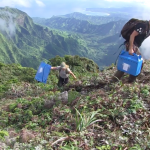HONOLULU -- The public is invited to the annual Arbor Day plant sale on Friday, November 4 from 9 a.m. to 12 noon at the Department of Land and Natural Resources, Division of Forestry and Wildlife O‘ahu plant nursery at 2135 Makiki Heights Dr., in Honolulu.
Forestry & Wildlife Announcements
(Click on image to watch video) Extraordinary Endangered Seabirds & Extraordinary Steps to Save Them Kauai Endangered Seabird Recovery Project Pacific Rim Conservation DLNR/Division of Forestry & Wildlife DLNR/Natural Area Reserve System American Bird… Read More »
LIHU'E – School children from Island School helped release five fledgling ‘A‘o (Newell’s Shearwaters) and one Leach's Storm-petrel yesterday as part of the annual E Ho‘opomaika‘i ‘ia na Manu ‘A‘o (A Cultural Release of the Native Newell’s Shearwater) event. The event was organized by the Kauai Endangered Seabird Recovery Project (KESRP) and the Save Our Shearwaters (SOS) project.
HONOLULU -- A draft management plan to help in the restoration and recovery of many rare plants and animals in the Pahole Natural Area Reserve (NAR) of O‘ahu’s Waianae mountain range is now available for public review and comment. The plan, prepared by the Department of Land and Natural Resources Division of Forestry and Wildlife (DOFAW), outlines the planned management activities in the reserve over the next 15 years. It is part of a series of site-specific plans to be prepared by DOFAW for natural area reserves throughout the state.
HONOLULU -- The Department of Land and Natural Resources announces the opening of the 2016-2017 Game Bird Hunting Season on Saturday, November 5, 2016. Department biologists are predicting a below average season of bird hunting, with lingering drought impacts in many parts of the state. The fall game bird hunting season will run through Sunday, January 29, 2017. A valid hunting license and a game bird stamp are required for all game bird hunting on public and private lands. All game bird hunting is regulated by Hawaii Administrative Rules Title 13, Chapter 122 (see https://hawaii.gov/dlnr/dofaw “Administrative Rules” for all legal hunting days).
(Kīlauea, Kaua‘i) – At the Nihoku predator-proof enclosure at the Kīlauea Point National Wildlife Refuge, it was designated Newell’s Shearwater (‘A‘o) Chick #8. On Sunday evening this healthy chick left its manmade burrow and headed out to sea; one of eight young birds that had been translocated to Nihoku as part of an extraordinary effort to save Hawai‘i’s endemic seabirds from extinction.
ANNOUNCEMENT FOR THE 2016-2017 GAME BIRD HUNTING SEASON The Department of Land and Natural Resources announces the opening of the 2016-2017 Game Bird Hunting Season on Saturday, November 5, 2016. Department biologists are predicting a… Read More »
HONOLULU – The Department of Land and Natural Resources (DLNR), Division of Forestry and Wildlife has set a makeup hunt on Saturday and Sunday, October 29-30, 2016 for those hunters impacted by cancellation of the Lana‘i mouflon sheep rifle hunt originally set on September 3-4, 2016.
The State of Hawaii, Department of Land and Natural Resources, Division of Forestry and Wildlife (DOFAW) is pleased to announce that application forms for the 2017 Lanai Axis deer hunting season, together with instruction sheets,… Read More »
HILO -- The Department of Land and Natural Resources (DLNR) Division of Forestry and Wildlife (DOFAW) will conduct animal control activities specifically for trapping mouflon/feral sheep hybrids; staff hunting, and/or aerial shooting from helicopters for feral goats, feral sheep, mouflon and mouflon/feral sheep hybrids within palila critical habitat in the Mauna Kea Forest Reserve (Unit A), Mauna Kea Ice Age Natural Area Reserve (Unit K), Palila Mitigation Lands, and the Ka‘ohe Game Management Area (Unit G) on the island of Hawai‘i.

